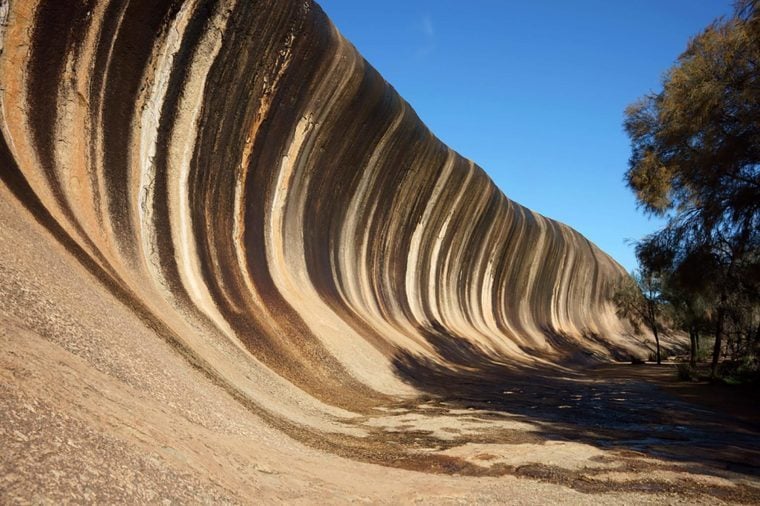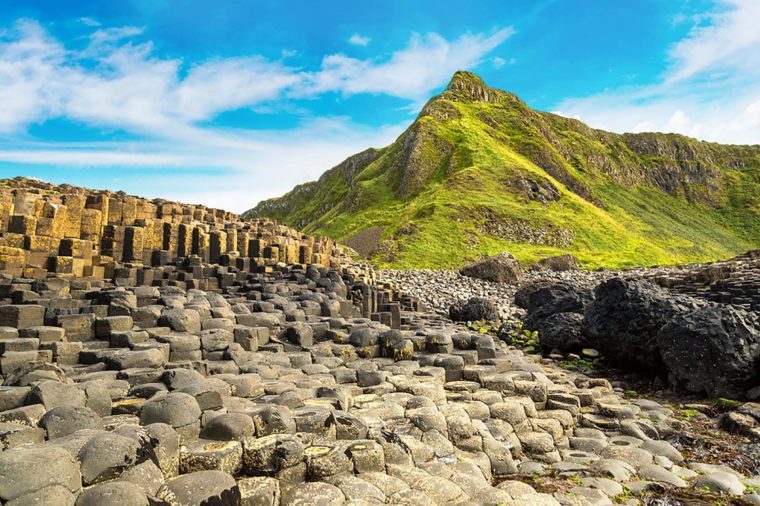 |
| ALESSANDRO PIERPAOLI/SHUTTERSTOCK |
BY BRITTANY GIBSON, Reader's Diegest
Hat's off to Mother Nature for these beauties.
Balanced Rock–Garden of the Gods, Colorado Springs, Colorado, U.S.
 |
| NAUGHTYNUT/SHUTTERSTOCK |
We know what you're thinking: how is this possible? Well, this 700-ton red sandstone rock has been putting on this balancing act for two to three million years, but its history goes far beyond that. It started to form over 290 million years ago as Fountain Formation sandstone was deposited along the Ancestral Rockies (aka a different set of Rocky Mountains that once existed there). Thomas Grose, geology professor emeritus at the Colorado School of Mines, explains that Balanced Rock "was sculpted over the following millennia by glaciers, rivers, wind, and rain." Since then, erosion has continued to occur, leaving visitors and geologists wondering when the beloved rock will eventually tumble. (You won't want to miss these stunning sea caves around the world.)
Reed Flute Cave–Guilin, Guangxi, China
 |
| WASSILIY ARCHITECT/SHUTTERSTOCK |
[post_ads]Reed Flute Cave, named after all of the reeds growing in the entryway, has quite the extensive history, notes Atlas Obscura. From its interior serving as a canvas for ink writings dating back to 792 CE to being a hideout for refugees during World War II, this cave has quite the story to tell. Perhaps the most astonishing qualities of Reed Flute Cave are its gorgeous rock formations stretching from the floor to the ceiling. Formed by centuries' worth of water erosion carving into the soft limestone, the cave's stalactites, stalagmites, and tall columns are now illuminated by a neon light show for all of its visitors to enjoy. (Check out these incredible natural hot springs around the globe.)
Hoodoos–Göreme National Park, Cappadocia, Turkey
 |
| FILIP FUXA/SHUTTERSTOCK |
Göreme National Park in Cappadocia, Turkey, is home to hundreds of hoodoos. The hoodoos, which are sometimes called "fairy chimneys," were formed millions of years ago by a volcanic eruption that rained ash across the area. Soon after, the ash hardened and transformed into tuff, a porous rock, which was then covered by a layer of basalt. Over time, the soft tuff eroded while the harder tuff took (and is still taking) its time—hence the mushroom-shaped caps on top of each pillar. (Fun fact: There are tons of ancient underground settlements to explore at the park.)
Svartifoss–Vatnajökull National Park, Iceland
 |
| ALESSANDRO PIERPAOLI/SHUTTERSTOCK |
You get to see more than just a gorgeous 39-foot tall waterfall when you visit Svartifoss in Iceland—its backdrop makes it look even more magical. As centuries passed and lava flows cooled, black hexagonal crystals began to form behind the waterfall. The only downside? You can't go for a swim in the waters beneath the falls—they're filled with dangerously sharp rocks. (You'll definitely want to add these beautiful travel destinations to your bucket list.)
[post_ads_2]
The Wave–Kanab, Utah, U.S.
 |
| PUNG/SHUTTERSTOCK |
We can thank Jurassic wind patterns for the Wave's gorgeous aesthetic in the northern section of Coyote Buttes. This sandstone rock formation is made of sand dunes that have been blown in different directions. Ultimately, all that sand cemented leaving linear marks. According to utah.com, "the water drainage that carved the two main chutes dried up a long time ago, so now wind is the Wave’s primary erosional force." (These beautiful pink sand beaches will take your breath away.)
Hoodoos–Bryce Canyon National Park, Utah, U.S.
 |
| YAYA ERNST/SHUTTERSTOCK |
While the hoodoos in Turkey were pretty impressive, Bryce Canyon National Park in Utah takes the cake for the having the most "fairy chimneys" in the world, according to the National Park Service. Ranging from around five-feet tall to 150-feet tall, these hoodoos have been around for 30-40 million years. Around that time, these rocks began to form in an ancient Lake in western Utah and were colored by mineral deposits. Unfortunately, the fairies will have to find other chimneys eventually. These hoodoos typically have an erosion rate of two to four feet every 100 years, which is primarily due to frost wedging and slightly acidic rainwater. (These beaches have the clearest water in the world.)
The Organ Pipes–Organ Pipes National Park, Victoria, Australia
 |
| DOROTHY CHIRON/SHUTTERSTOCK |
[post_ads]Unsurprisingly, the Organ Pipes in Organ Pipes National Park is known for, well, looking like organ pipes. In fact, they're even referred to as an "outdoor cathedral." Over one million years ago, lava from Mt. Holden made its way down to active volcano plain—which would soon be home to the Organ Pipes. The cooling and cracking of the lava left behind the beautiful 229-foot tall basalt columns that are there today. (Is it just us or do these national parks look even more gorgeous covered in snow?)
The Great Tsingy–Tsingy de Bemaraha National Park, Madagascar
 |
| PIERRE YVES BABELON/SHUTTERSTOCK |
Tsingy de Bemaraha National Park in Madagascar isn't a National Heritage Sitewithout reason. Over 200 million years ago, a limestone seabed rose to create a plateau in what is now Tsingy de Bemaraha National Park. Over the years, heavy rain did its part in creating the natural masterpiece that is there now. The gorgeous rock formations make up a "vertical cathedral of limestone," some of which are as tall as 328 feet. The Great Tsingy is perhaps one of the most intriguing formations. The word "tsingy" translates as "walking on tiptoes," which is appropriate based on how many limestone needles occupy the park's grounds.
Wave Rock–Hyden, Western Australia
 |
| MARCO TOMASINI/SHUTTERSTOCK |
Shaped by weathering and water erosion, Wave Rock in Western Australia is 49 feet tall and 360 feet long. During wetter months, springs running down the rock dissolve minerals, which add to the rock's unique coloring. This rock formation also has some of the oldest crystals in Australia. In fact, in 1960, they were dated to be around 2,700 years old. (These are the best family travel destinations in every U.S. state.)
[post_ads_2]
Giant's Causeway–Bushmills, Northern Ireland
 |
| S-F/SHUTTERSTOCK |
Legend has it, this Irish causeway was used by giants to travel across the sea to Scotland—and we can see why people think that. Giant's Causeway in Northern Ireland is made of 40,000 basalt columns protruding from the sea's surface. This World Heritage Site forms a pavement out of the columns, which are the result of lava cooling around 50 to 60 million years ago. Now that you've added all of these destinations to your must-visit list, these are the ten places you NEED to visit this year.

























